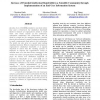Free Online Productivity Tools
i2Speak
i2Symbol
i2OCR
iTex2Img
iWeb2Print
iWeb2Shot
i2Type
iPdf2Split
iPdf2Merge
i2Bopomofo
i2Arabic
i2Style
i2Image
i2PDF
iLatex2Rtf
Sci2ools
HICSS
2003
IEEE
2003
IEEE
Increase of Potential Intellectual Bandwidth in a Scientific Community through Implementation of an End-User Information System
Qureshi, et al. (2002) [1] presented a case study where they used a framework, the Intellectual Bandwidth Model to measure an organization’s ability to create value. The model consists of two dimensions, information assimilation and collaboration. The IB model is a useful tool for managers because it enables them to plan solutions to complex business problems and to easily communicate these plans to key individuals. The model can also serve as a guide when making investment decisions. While it is important to increase an organization’s intellectual bandwidth, it is equally important to assure that the resulting increase is employed to improve the organization’s ability to innovate since, as it has been shown, innovation is the number one creator of organizational wealth [2]. In this paper we discuss how intellectual bandwidth as proposed by Nunamaker et al. (2001) [3] can be extended beyond the highest level of information assimilation identified in the model, automated sensemak...
Biometrics | HICSS 2003 | Information Assimilation | Intellectual Bandwidth | Model | System Sciences |
| Added | 04 Jul 2010 |
| Updated | 04 Jul 2010 |
| Type | Conference |
| Year | 2003 |
| Where | HICSS |
| Authors | Christian Bach, Salvatore Belardo, Jing Zhang |
Comments (0)

